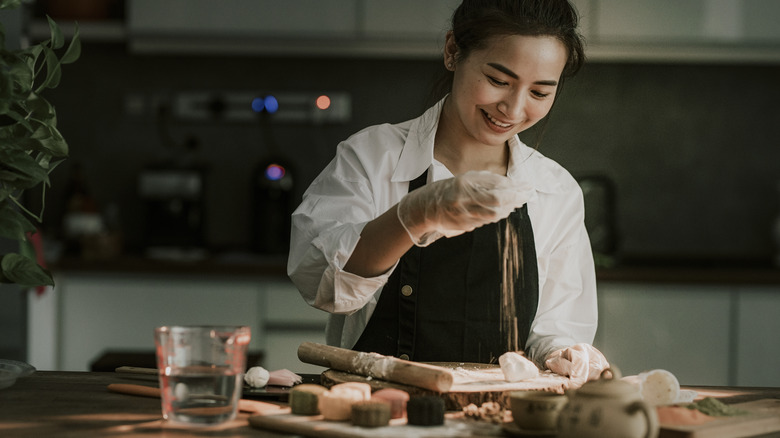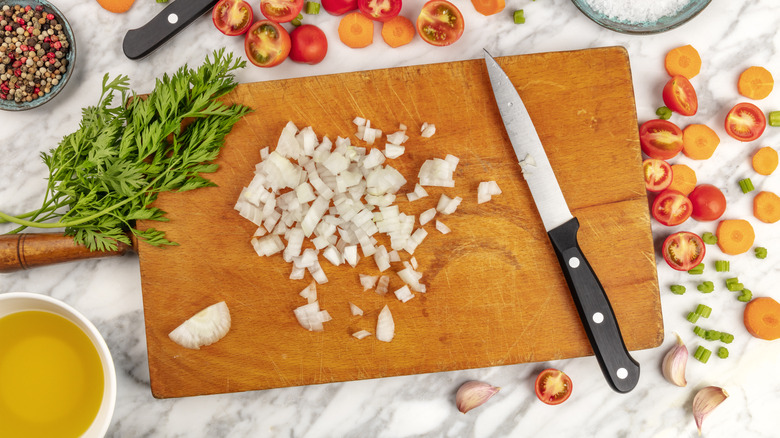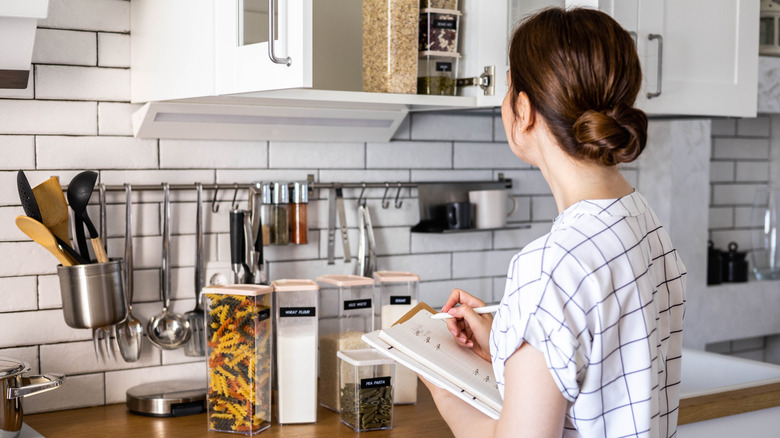The French Organization Practice That Will Bring Order To Any Baker's Kitchen
Think about the fanciest or most elaborate meal you've ever made. How long did it take, not counting the shopping — three or four hours (maybe five hours, if you were dating)? But the recipes always hint that your dish should have been done in far less time. The reason is often right there in the recipe, an item labeled something like "prep time." The best way to bring efficiency (and order, safety, and quality) to a kitchen is a practice called mise en place, a French term meaning "in its place."
You must prepare and organize everything in advance to pull off a great meal in a reasonable amount of time... and you must have your own kitchen organized so that mise en place is even possible. Culinary great Georges-Auguste Escoffier came up with this notion of organization after his experience organizing a French army kitchen, but military efficiency isn't how we like to think about cooking. We might imagine cooking as freewheeling artistic expression, but improvisation and creativity happen when the fundamentals are all in order. Tossing in a shallot or a splash of acid might save a dish, but only because the lack of planning and preparation made saving the dish necessary. Instead of cultivating that kind of pressure, why not create a situation in your home where everything is likely to go perfectly, then add your personal flair?
Escoffier-style kitchen organization might seem extreme, but even simple advice from experts like Jasmine Roth can help you turn your cluttered kitchen into an organized masterpiece. Here's how to restructure your space with this concept in mind.
Mise en place: Putting everything in its place
Mise en place is about setting up for an individual meal, but it's both broader and narrower than that. Preparing absolutely everything in advance means that however far you zoom in or out of the process, things are orderly. That means you can work your plan rather than reacting to a hundred little problems like looking for missing ingredients, sharpening knives, or figuring out how to improvise a bain-marie. It's about doing everything you can in advance to make sure there are no distractions from cooking itself. This starts with the recipe, which dictates the ingredients you'll need, which equipment is necessary, and the order in which you'll need those things.
When you have a handle on your recipe, you prepare everything you can in advance. You'll know which measurements to convert into units relevant to you (what is 500ml of water?), which vegetables you'll need to chop or dice, and which meat will need to be trimmed. You'll measure everything out, do whatever knifework is called for, and place the dish's components in separate containers in order so they can be grabbed and used easily as you cook. If you've been to a Japanese teppanyaki restaurant where meals are cooked before you on a griddle, you've seen the value of thorough organization. Everything is at hand in the right order and quantities, and the chef is flipping shrimp at another group of diners before you even notice he's moved on. You need one more thing for mise en place to do its magic... a cooking space that allows you to work the system.
Setting up your own kitchen for mise en place
So, if you want to create this in your own home, the key is the concept of stations: Each type of activity requires a different set of tools and ingredients, and so should have a space dedicated to it. This might sound ridiculous to the home chef without acres of counter space and with no need for a saucier station. But a "station" in your home kitchen could be as simple as a separate cutting board and tools. Keep your vegetable prep station near the sink, use different cutting boards for veg and meats, and have a space to lay your tools out in the order they're needed. A baker's pastry board might be best stationed on a kitchen island, while meat should be prepped as close to the stove as possible.
Having everything prepared and portioned in advance means you'll need a lot of prep bowls. Trash and compost bins should be near where they'll be used. And there's one final piece of advice that you'll have to read twice to believe: Don't clean up as you go. It's a distraction from cooking and you shouldn't need to if your mise en place is properly set up. Think about service, too; some design experts say you should store dinner plates close to where they're going to be used. Stick the dishes in the sink and keep cooking. Cleanup is easier in the long run because mise en place is one of the habits of people with clean and organized homes.


